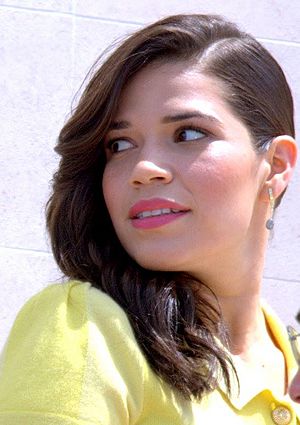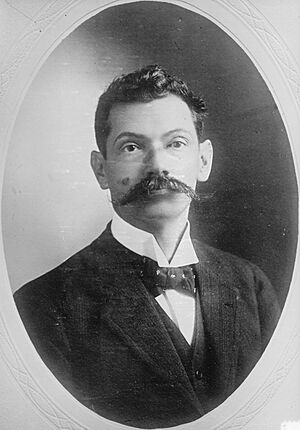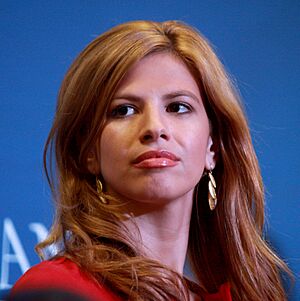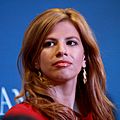Honduran Americans facts for kids
Quick facts for kids Total population |
|
|---|---|
| 1,083,540 (2019) 0.33% of the U.S. population (2019) |
|
| Regions with significant populations | |
| Languages | |
| American English, Honduran Spanish, Garifuna | |
| Religion | |
| Predominantly Roman Catholic Minority Protestantism |
|
| Related ethnic groups | |
| other Hispanic Americans |
Honduran Americans are people living in the United States who have family roots in Honduras. They are also known as Spanish: hondureño-americano. They are the eighth largest Hispanic group in the U.S. and the third largest from Central America, after people from El Salvador and Guatemala. Many Honduran Americans live in Texas, Florida, and California. They are now the largest immigrant group in Louisiana.
Contents
A Look at Honduran American History
Early Arrivals: 1800s
The first Hondurans came to the United States in the late 1700s and early 1800s. At that time, Honduras was known as the Intendencia de Comayagua. It was part of the Viceroyalty of New Spain. Later, in 1820, it became the province of Comayagua.
Honduras then gained its independence from Spain. For a short time, it was part of the Mexican Empire (1822-1823). After the empire collapsed, Honduras joined the Central American Federation from 1823 to 1838.
Growing Connections: 1900s

In the early 1900s, Honduras and the United States became closer. People could move between the two countries more easily. This was often because of banana companies. One famous Honduran American from this time was Steve Van Buren. He was a football player born in La Ceiba, a city that was growing economically.
Even with political changes and conflicts, most Hondurans, who were often farmers, had a stable life. This changed in the mid to late 1900s when there were many changes in government. These conflicts led to small groups of Hondurans moving to the U.S. For example, some left after a military change in 1956. However, Honduras had very low crime rates in the 1960s and 1970s.
More Hondurans moved to the U.S. in the 1960s. They mainly went to Miami, New York City, and Los Angeles. They hoped to escape poverty in rural areas and find a better life. The biggest wave of Honduran migration started in the late 1980s. This was when Honduras began to face economic and political challenges. Some Jewish-Hondurans also left after a political event in 2009 due to rising tensions.
Hondurans Today
Today, Hondurans are one of the largest Latino groups in the U.S. They are alongside Mexicans, Puerto Ricans, Dominicans, and Cubans. Many Honduran Americans live in Houston, New York City, Miami, Indiana, and Washington, D.C.
Many have started businesses, like coffee shops. Others use their university education to work in different fields. Some Hondurans have moved to the U.S. legally. Others have traveled with groups of migrants from Central America, like the migrant caravan in 2018.
Why People Move: Causes of Migration
Experts have different ideas about why so many Hondurans have moved. Some point to problems in the government. Others say that a small group of powerful people still controls Honduras. Some believe that certain economic policies have failed. However, the most common ideas involve Honduras's economic system and past U.S. actions in the country.
Cold War Influence

Many experts believe a big reason for the large migration starting in the late 1980s was the strong influence of the United States in Honduras. This influence grew during the time of President Reagan. The 1980s saw many U.S. soldiers in Honduras during the Central American Crisis.
The U.S. government sent soldiers to a base in Honduras. Their goal was to stop the spread of communism in Central America. President Reagan saw Honduras as an important place to increase U.S. influence in the region. This period greatly shaped the relationship between the U.S. and Honduras.
American Company Ties
Some people say that U.S. companies also played a role in migration. Banana and mining companies like Standard Fruit Company and Rosario Mining Company had a big presence in Honduras. Some experts say these companies treated Honduras like a U.S. colony. They also say the companies did not treat their workers fairly.
Many Honduran Americans are the children or grandchildren of farm workers. These families first settled in large U.S. cities. They found support from other Honduran American communities there. In the late 1980s and 1990s, many Honduran Americans lived in New Orleans, New York City, Los Angeles, and Miami. By 2000, Hondurans became the third largest immigrant group from Central America.
Contributions to American Society
Arts and Entertainment
Many Honduran Americans have made important contributions to art, film, and television. Famous examples include Carlos Mencia and America Ferrera. In fashion, they have brought Honduran cultural styles to their designs. Many young Honduran Americans study different art forms in colleges.
Music
Honduran music has two main styles. La Punta comes from Afro-Caribbean traditions, especially the Garifuna people. Marimba music is more connected to the mixed-heritage identity of the country. Honduras also has its own versions of other Latin music styles, like salsa. Some Hondurans have also contributed to rock music, which was popular in Honduras in the 1980s and 1990s.
Military Service
Honduran Americans have served in the U.S. military since World War II. Some fought in North Africa, the Pacific War, and the occupation of Japan. A well-known story is about Luis Alemán Gomez, a Honduran U.S. soldier who was part of the Allied forces in Japan. About 13.7 percent of U.S.-born Honduran American males over 16 serve in the military. Also, 769 Honduran American non-citizens serve.
Socioeconomics and Education
Honduran Americans often live in areas with good job opportunities. These jobs are often in construction, home services, and other industries. Like other Hispanic groups, some Honduran Americans face discrimination, especially Afro-Hondurans.
Honduran American girls tend to stay in school longer than boys. This is partly because families sometimes expect boys to start working at a younger age, around 12 or 14. Many Honduran Americans have achieved higher education. Over 1,000 have master's degrees, and hundreds have other professional or doctoral degrees. Most of these highly educated individuals are women.
Demographics: Where Hondurans Live
According to the 2010 United States Census, there were 633,401 Hondurans living in the United States. By 2011, the number was estimated to be 702,000. In 2014, Pew Research reported that about 60% of the 573,000 Honduran immigrants in the U.S. were unauthorized.
The 2020 census showed that 1,061,585 Honduran Americans lived in the U.S.
The 10 U.S. states with the most Honduran populations in 2020 were:
- Texas – 168,578
- Florida – 153,308
- California – 102,491
- New York – 93,056
- North Carolina – 57,822
- Louisiana – 55,915
- New Jersey – 55,819
- Virginia – 53,664
- Maryland – 44,183
- Georgia – 31,832
Notable People
- Alessandro Castro – soccer player
- Teofilo Colon Jr. – photographer, filmmaker, writer, and journalist
- Ronnie Aguilar – basketball player
- David Archuleta – singer, runner-up of American Idol Season 7
- Michael Benjamin (investor) – investor
- Bianca Del Rio – actor, comedian, costume designer, and drag queen
- Brandon Escobar – wrestler
- Empress Of – singer
- Kat Fajardo – author
- America Ferrera – film actress (Real Women Have Curves, The Sisterhood of the Traveling Pants, Ugly Betty)
- Michelle Fields – political journalist
- Brian Flores – former Head Coach for the Miami Dolphins
- Samuel Gómez – soccer player
- Illich Guardiola – American actor
- Ali Hall – soccer player
- Teófimo López – professional boxer, world lightweight champion
- Dewan Hernandez – basketball player
- Maximiliano Hernández – film actor (Captain America: The Winter Soldier, Sicario, The Last Ship)
- Maity Interiano – journalist and television producer
- Skai Jackson – actress
- Karrie Martin – entrepreneur
- Walmer Martinez – soccer player
- Annia Mejia – soccer player
- Juan Carlos Obregón Jr. – soccer player
- Brina Palencia – voice actress and singer
- Francia Raisa – actress
- Taxstone – television and podcast personality
- Andres Serrano – photographer and artist
- Hype Williams – music video and film director
- Sauce Walka – rapper
- Sha EK – rapper
Images for kids
See also
 In Spanish: Inmigración hondureña en los Estados Unidos para niños
In Spanish: Inmigración hondureña en los Estados Unidos para niños







